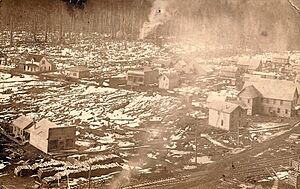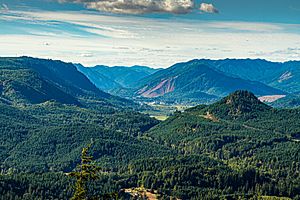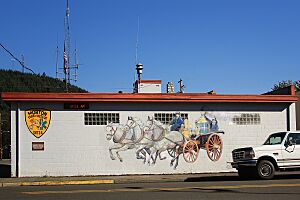Morton, Washington facts for kids
Quick facts for kids
Morton
|
|
|---|---|
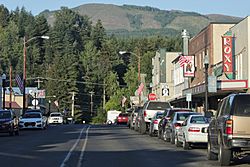
Main Street, Morton, Washington
|
|
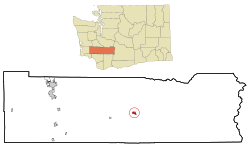
Location of Morton, Washington
|
|
| Country | United States |
| State | Washington |
| County | Lewis |
| Incorporated | January 7, 1913 |
| Area | |
| • Total | 0.83 sq mi (2.16 km2) |
| • Land | 0.82 sq mi (2.13 km2) |
| • Water | 0.01 sq mi (0.03 km2) |
| Elevation | 948 ft (289 m) |
| Population
(2020)
|
|
| • Total | 1,036 |
| • Density | 1,460.41/sq mi (563.60/km2) |
| Time zone | UTC-8 (Pacific (PST)) |
| • Summer (DST) | UTC-7 (PDT) |
| ZIP code |
98356
|
| Area code(s) | 360 |
| FIPS code | 53-47175 |
| GNIS feature ID | 1523383 |
Morton is a small city in Lewis County, Washington, United States. It's home to about 1,036 people, according to the 2020 census.
Contents
History of Morton
Early Days
Morton was first settled in 1871 by James Fletcher. The city was later named in 1889 after Levi P. Morton, who was the Vice President under Benjamin Harrison. Morton officially became a city on January 7, 1913.
Fires and New Roads
In July 1924, a big fire destroyed a large part of Morton's downtown area. It affected 18 blocks and burned down 19 business buildings. Luckily, most homes were saved, and only one person had a minor injury. Several years later, another fire hit the area, burning the post office.
The White Pass Highway (which is part of U.S. Route 12) was moved through Morton in December 1967. This happened because Riffe Lake was created behind Mossyrock Dam, and the old road became covered by water.
Recent Times
In 2022, the city of Morton decided to leave the Timberland Regional Library district. This meant the city no longer had a public library or a library system supporting it.
In 2024, a financial review of Morton's government accounts was completed. It showed a significant loss of money from the city's funds. Investigations suggested that a city official, who managed the accounts for many years, was responsible for the missing money. The official resigned in 2021, and the city has since changed how its financial roles are managed.
Geography and Climate
Morton covers an area of about 0.83 square miles (2.15 km2). Most of this area is land, with a small part being water.
Weather in Morton
Morton has warm, dry summers, but they are not too hot. The average monthly temperatures don't go above 71.6 °F (22 °C). This type of weather is known as a warm-summer Mediterranean climate.
People of Morton (Demographics)
2020 Census Information
In 2020, Morton had a population of 1,036 people. Most residents were White (88.1%). About 7.7% were from two or more races, and 6.6% were Hispanic or Latino.
The average age in the city was 49.5 years old. About 18.2% of the population was under 18. The city had slightly more males (53.6%) than females (46.3%).
| Historical population | |||
|---|---|---|---|
| Census | Pop. | %± | |
| 1920 | 522 | — | |
| 1930 | 461 | −11.7% | |
| 1940 | 778 | 68.8% | |
| 1950 | 1,140 | 46.5% | |
| 1960 | 1,183 | 3.8% | |
| 1970 | 1,134 | −4.1% | |
| 1980 | 1,264 | 11.5% | |
| 1990 | 1,130 | −10.6% | |
| 2000 | 1,045 | −7.5% | |
| 2010 | 1,126 | 7.8% | |
| 2020 | 1,036 | −8.0% | |
| U.S. Decennial Census 2020 Census |
|||
2010 Census Information
In 2010, Morton had 1,126 people living in the city. The population density was about 1,373.2 inhabitants per square mile (530.2/km2). Most people were White (94.2%).
The median age was 46.3 years. About 20.3% of the population was under 18 years old.
Economy of Morton
In the past, Morton's economy relied on logging, collecting cascara bark, and mining for cinnabar (which is mercury ore). In the 1950s, Morton was famous as the "tie mill capital of the world" because it produced so many railroad ties.
Today, timber processing and logging are still very important to Morton's economy. Even though the community faced challenges when timber production decreased, there are still two lumber mills in town as of As of 2024[update].
Arts and Culture in Morton
Supporting the Arts
The Fire Mountain Arts Council (FMAC) is a non-profit group that supports the arts in Morton. They bought the Roxy Theater and worked to restore it. The FMAC also runs an art gallery and the Tiller Arts and Events Center in Morton.
Fun Festivals and Events
The Morton Loggers’ Jubilee is a popular weekend festival that celebrates the city's logging history. It usually happens in August. This event has been a tradition since the 1940s and is known as the "granddaddy of all logging shows."
Highlights of the Jubilee include:
- Crowning a Jubilee Queen.
- Exciting lawnmower and bed races.
- Competitive logging contests, which continue the festival's original idea of friendly competition among loggers.
The festival also features a parade, a flea market, live music, and street dance performances. Visitors are greeted by a wooden sculpture of a lumberjack named "Big Ole," showing how important the Jubilee is to the community.
Historic Places to See
The downtown area is home to the Roxy Theater, which first opened in 1938. It used to be called the Arcade Theater. After being closed for many years, the Roxy Theater was restored and fully reopened in 2007 for movies and live shows. It also has an art gallery. More renovations were completed in 2024, adding a backstage area.
Parks and Recreation
Morton has two main parks:
- Jubilee Park: Located on the east side of Morton, this park is where the Loggers Jubilee takes place.
- Gust Backstrom City Park: This park is next to the Tilton River. It often hosts the city's farmer's market. In 1896, the first schoolhouse in Morton was built on these grounds. The park is also used by the Washington Department of Fish and Wildlife to help Chinook salmon get around dams on the Cowlitz River.
Education in Morton
Morton has two schools: Morton Elementary and Morton Junior-Senior High. Centralia College East is located right next to the Junior-Senior High facility.
The Morton-White Pass boy's high school basketball team won state championships two years in a row, in 2014 and 2015. Their first title was won during a season where they didn't lose a single game!
City Infrastructure
Morton is part of a project to install EV charging stations along the White Pass Scenic Byway. This project, which started in 2023, will help people with electric cars travel from the White Pass Ski Area to Chehalis.
In 2023, Lewis County Transit started a new bus route called the "Brown Line." This route connects Morton to Centralia, making it easier for people to travel and connect to other bus services in western Washington.
Strom Field Airport
Strom Field Airport is a small airport located southeast of downtown Morton. It was built between 1964 and 1965 and is named after Stan T. Strom, who loved aviation. The airport has one runway that is 1,810 feet (551.7 m) long and 40 feet (12.2 m) wide.
Notable People from Morton
- Bill Bryant: A Seattle Port Commissioner.
- Brandy Clark: A singer and songwriter who has written songs for many famous country artists like LeAnn Rimes and Reba McEntire.
- Roger "Buzz" Osborne: The singer, songwriter, and guitarist for the rock band Melvins.
- T.A. Peterman: The person who founded Peterbilt Motors Company, which makes trucks.
Images for kids
See also
 In Spanish: Morton (Washington) para niños
In Spanish: Morton (Washington) para niños


